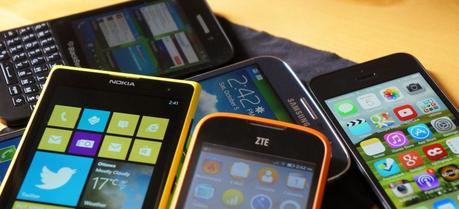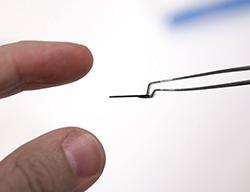 In the future mobile devices may be powered by alcohol. (Credit: Flickr @ Jon Fingas https://www.flickr.com/photos/jfingas/)
In the future mobile devices may be powered by alcohol. (Credit: Flickr @ Jon Fingas https://www.flickr.com/photos/jfingas/)Gianmario Scotti, a scientist working at at Aalto University, has developed economical and rapid methods for the purpose of fabricating micro fuel cells that generate electrical energy from hydrogen, ethanol and methanol.
Fuel cells have up to this point been utilized mostly in motor vehicle applications and in small combined-production electrical and heating systems. Due to their high energy density, they also represent an attractive alternative source of electric power for mobile applications, though in miniature form.
“Micro fuel cells have initially been made using mature microfabrication technologies from the semiconductor industry,” Gianmario Scotti, who is studying for his doctorate, explains, while displaying a square-shaped aluminum plate.
“The size of one cell is 14 mm2, and its thickness is about a millimeter. When fueled with methanol or other alcohol, it delivers 0.5 volts, while with hydrogen it produces one volt at best. A phone requires several micro fuel cells, but even so their total weight is only a fraction of the weight of a rechargeable battery.”

The size of one micro fuel cell is 14 mm2, and its thickness is about a millimeter. (Credit: Aalto University)
So that a micro fuel cell can become a real competitor for a battery, micro manufacturing techniques must be economical and fast. In his doctoral research, Scotti succeeded in, for instance, making high-performance micro fuel cells by replacing their normally used material – silicon – with more cost-effective aluminum. In addition, he improved the manufacturing technique known as laser ablation so that the total number of working stages was reduced and the preparation of prototypes was accelerated.
Globally micro fuel cells are already utilized for military purposes in electrical equipment, and next in line appear to be satellite phones designed for extreme conditions. It is still necessary to wait for them to be incorporated in basic mobile and other mobile devices, however.
“1–10 years” is Gianmario Scotti’s forecast.
“There are still many challenges ahead. We should, for example, resolve what the best method is to get the fuel into the cells—should we do so by pumping or use capillary functions? The surrounding air can also pose a problem. In a nutshell, it can be said that what’s bad for the lungs is also bad for micro fuel cells. In Finland, the air is clean, but in Shanghai, for example, pollution could cause problems for the micro fuel cells unless the air is filtered.”
Technologies developed in micro fuel cell research can be utilized in the development of rechargeable batteries as well as in microfluidics (utilized, for instance, in medicine and chemical engineering). Scotti predicts a future for micro fuel cells in outer space for micro-satellites and similar space probes.
“Each gram sent into geostationary orbit costs 20–30 euros, so there is a strong incentive to invest in light and effective energy sources with high energy density.”
Earlier we reported that NASA is seeking proposals for the development of new energy storage technologies to replace the battery technology that has long powered America’s space program.

